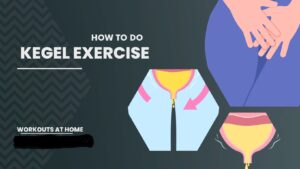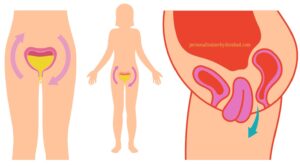Self-Care With Kegel Exercises
Kegel exercises can aid women and men with bowel leakage or control issues.
Exercises with Kegel can be performed anytime you’re lying or sitting down. It is possible to do them while you’re sitting at your desk or taking a break.

Kegels Meaning
Kegel exercises, commonly called pelvic floor muscles training, are simple exercises that can help alleviate bladder problems and improve the flow of the bowels.
How to do Kegel Exercises
A Kegel exercise involves pretending to urinate and holding it for a while. As you loosen and tighten your muscles that control the flow of urine. It is essential to locate the muscles that are tight enough to be tight.
Kegel exercises: A step-by-step guide for women

Kegel exercises are beneficial for women.
- Kegels can be a great sex product for females:
Concerning sexual activity, Kegel exercises make the vagina appear tighter and could assist in increasing the sex’s intensity. These pelvic muscles play a crucial role in the orgasm process.
Vaginal organs are responsible for the delightful contractions in the male genitals. If the pelvic muscles are healthy and strong, the orgasms will last longer. Women might have difficulty having an orgasm if they suffer from weakness in the pelvic muscle.
Exercise on the floor will increase the supply of blood to the pelvis. The increased blood flow can increase sexual arousal, lubrication, and the capacity to gasp.
The pelvic floor muscles are flexible, allowing for more comfortable vaginal insertion. Women with pain in their vagina should consult a pelvic therapy therapist since they could be experiencing vaginismus. These workouts are painful, involuntary contractions that vaginal muscles undergo.
Vaginismus is a medical condition that can be treated with a proper treatment plan that can allow for a pleasurable interaction without pelvic pain. Increase the strength of pelvic floor muscles by using an Intimate Rose vaginal weight-training system.
- Kegels can improve general fitness:
Sitting for long periods and repetitive motions, injuries, and pregnancy can destroy your body in various ways. Sitting for long periods can cause a general decline in fitness and strength training.
Regular exercise can reduce negative effects and help you regain form faster after a hard day.
Since the pelvic floor gets less flexible with sitting for a long time and a sprain on the hip, lower back, or pelvis during pregnancy, including exercises for your pelvic floor in your workout routine, is vital. A well-trained pelvic floor can lower the chances of experiencing pelvic organ prolapse, urinary incontinence, and painful intercourse.
- Kegel Exercises can benefit the general health of the pelvis during menopausal changes: In menopausal women, fluctuations in estrogen levels can result in lower blood flow to the pelvic muscles and a decrease in muscle strength. Imagine your pelvic floor like a sponge with soapy sludge that you are squeezing in clean, running water. You squeeze out the soap and allow the sponge to fill with fresh water while you ease your grip on the floor.
- Kegels can assist in the recovery process following:
Pelvic floor muscles could weaken during pregnancy, whether you have your baby through vaginal delivery or a cesarean. This weakness may be further aggravated during vaginal birth, resulting in muscle tearing and even episiotomy.
The positive side is that this muscle will heal the same way as other muscles and react to Kegel exercises that increase endurance just as other muscles do.It is possible to start strengthening the pelvic floor before becoming pregnant. You can continue to strengthen it during your pregnancy by doing Kegel exercises so long as you don’t feel contractions in your uterus when you do them. If you are expecting to talk about your exercise routine with your physician and an experienced fitness instructor is essential.
- Kegels may reduce Pelvic Organ Prolapse:
Pelvic organ prolapse (POP) is a condition where one or more organs of the pelvis press against the vagina’s wall. This is usually the result of abdominal muscles of the pelvic floor or ligaments stretched or weak, like during pregnancy or childbirth.
Women also may develop POP after prolonged lifting during exercise or work and more serious conditions such as constipation, excessive coughing, or weight gain. Pelvic organ prolapse isn’t dangerous, but it may result in pain, fear, and problems with the bowel or bladder.
They can also be observed using a hand-held mirror, which allows you to see an opening in the vagina. The pelvic organs might be weighing heavy or falling from the body. The pressure could increase during the evening, following exercise or physical exertion like heavy lifting.
POP is triggered by tears and weakening pelvic floor muscles or tendons that suspend the organs. It is believed that up to 50 percent of women who have a child will suffer from prolapse in some way.
Age also plays an important role in the development of POP for most women above 50 years.
Women with more than two kids are more at risk of developing POP. Women who have had a C-Section may also suffer from POP, particularly if they’re pushing during labor before having C-sections. Sit-ups and crunches, as well as lifting heavy objects, should be avoided as they could cause the prolapse to worsen.
POP can be classified based on the organ falling into the pelvic bowl. A cystocele is a urinary prolapse along the lower vaginal wall. In addition, the cystocele can be described as a bladder prolapse via the upper vaginal wall.
A uterovaginal prolapse refers to the descending from the cervix, uterus, and the upper section of the vagina. Rectocele is an extrusion of the rectum to the vagina’s lower wall. At the same time, an enterocele can be described as an ailment of the upper vagina’s back, including small intestines.
The best part is that Kegels can aid in strengthening your pelvic floor muscles to assist the pelvic organs and decrease prolapse. Prolapse that is not severe is completely curable, and moderate levels could be managed to a level that doesn’t hinder daily activities.
- Kegels exercises are a cure for leaky bladder:
Pelvic floor muscles support the uterus, bladder, and rectum when you are doing the workout. The bladder and the neck of the bladder are less supported if these muscles aren’t robust and well-coordinated.
Incontinence due to stress is the result of bladder leakage. It occurs during strenuous motions like exercises, lifting large objects, and coughing, sneezing, or laughing. Kegels are the most effective treatment for urinary problems. Find our top-of-the-line premium Kegels and stop leakage from the bladder.
- Kegels can help develop better back and hip support:
Pelvic floor workouts are part of the inner core muscles, which support the trunk and hips. The muscles are in sync with the deep layers of abdominal muscles to support the spine and connect with the hip rotator muscles in the deep layers to ensure hip stability. Suppose those pelvic muscles aren’t functioning properly and are not coordinated. In that case, this can impact those joints that connect the pelvis, tailbone, and lower spine. The study estimates that a third of females suffering from urinary leakage also experience lower back pain. Kegels help both.
Stops you from suffering bladder leaks: It could prevent you from blowing poo or wind. It can enhance orgasms and sexual pleasure.
- It could prevent you from blowing poo or wind. It can enhance orgasms and sexual pleasure: The pelvic floor may be stretched and weakened by pregnancy. Regular Kegels throughout pregnancy and following childbirth will help maintain the pelvic floor to treat incontinence and help prevent hemorrhoids. Kegels are recommended to be performed daily to ensure muscle strength.
- Patients suffering from stress incontinence: Stress incontinence occurs when urine leaks out when you laugh, cough or sneeze, jump, or lift something heavy. Kegels will help stop the leaks.
- Young women: Regular Kegel exercises keep muscles tense and aid in the most enjoyable sexual experience.
Like any exercise, be sure to consult with your physician before you begin. Remember to take action! Training is better at stopping a problem than treating it.
Kegel exercises: A how-to guide for Men
Kegel exercise is beneficial for males.
When we think of exercising the pelvic floor, we usually believe this is just for women. But, men can, too, gain from Kegel exercises.
The pelvic floor muscles could be beneficial as they: It could also increase leaks from the bladder, particularly if it is caused by urinary stress. It can help ease prostate pain and swelling that could occur after surgery.
Enhance the feeling of an orgasm. They can also assist in reducing ejaculation. It is possible to stop dribbling wee once you’ve exited the toilet.
Step-by-step instruction for practicing Kegel Exercises
At the beginning of the Kegel routine, remember that you’ll be working towards a higher level. Expect to keep your Kegel for less than five or ten seconds in a single session. Expect to see results after some time.
Here’s an Example program for how to start Kegels:
Begin by locating the pelvic floor muscles (using the above steps).
Begin by tightening your pelvic muscles for two seconds and relax for three seconds. Do it 10 times. If you find 10 too difficult, Reduce this by five until you become stronger.
Set one up in the morning and another at night.
As you get stronger, you can increase the number of repetitions. For instance, instead of holding your Kegels for three seconds and then taking a break in two minutes, you can hold and take ten seconds to relax each time. Later you can increase the number of repetitions to 10 per row.
Then you can increase the number of times you practice these exercises from once to 3 times daily.
Ideally, work to doing 10 Kegels in a set (holding and letting go for 5 seconds at a time) and completing three sets daily.
Examples are of Kegel exercise:
Lying Down: The position of lying down is an excellent starting point, particularly for those new to the workout, since your muscles don’t need to fight against the force of gravity the way they would when standing.
Sitting Down: Doing Kegel exercises at a desk is another excellent alternative. The benefits of strength and exercise can be more useful to the daily routine (after all, most of us spend most of our time sitting instead of lying down, even though we sometimes wish we were! )
According to research, the ideal sitting position is to have the lower part of your back bent towards the stomach button.
Standing: Standing with your feet hip-width apart and your feet pointed towards the inside will allow you to concentrate on the pelvic area and not tense your inner thighs. Engaging the pelvic floor muscles more than your abdominals or glutes is best. Be sure to stay erect and stop sliding like you do when sitting.





Its good as your other content : D, thankyou for putting up.